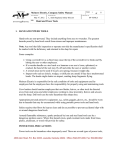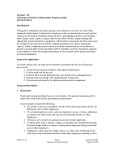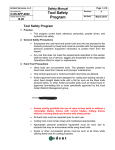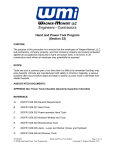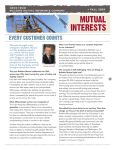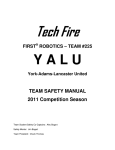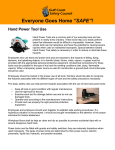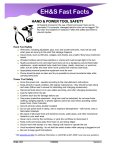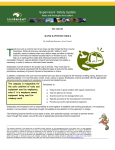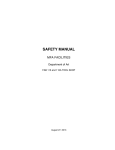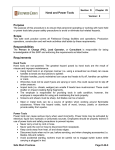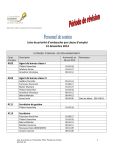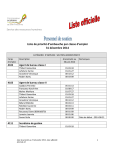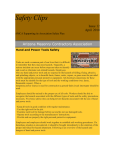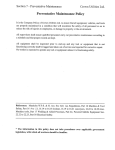Download Tool Safety Program
Transcript
Savard Labor & Marine Staffing, Inc. Tool Safety Program Rev3/14 Tool Safety Program Purpose: Use of tools makes many tasks easier. However, the same tools that assist us, if improperly used or maintained, can create significant hazards in our work areas. Scope: Employees who use tools must be properly trained to use, adjust, store and maintain tools properly. This programs covers hand, electrical, pneumatic, powder driven, and hydraulic tool safety. Responsibility: Management • Provide correct tools for assigned tasks • Ensure tools are maintained and stored safely • Provide employee training • Provide for equipment repair Employees • Follow proper tool safety guidelines • Report tool deficiencies and malfunctions • Properly store tools when work is completed Hazard Control Engineering • Properly designed tools • Guards & safety devices Administrative • Tool sharpening program • Use of PPE • Control of tool issue • Employee Training • Controlled access to equipment and tool areas General Safety Precautions Employees who use hand and power tools and who are exposed to the hazards of falling, flying, abrasive and splashing objects, or exposed to harmful dusts, fumes, mists, vapors, or gases must be provided with the particular personal equipment necessary to protect them from the hazard. 1 Savard Labor & Marine Staffing, Inc. Tool Safety Program Rev3/14 All hazards involved in the use of tools can be prevented by following five basic safety rules: • Keep all tools in good condition with regular maintenance. • Use the right tool for the job. • Examine each tool for damage before use. • Operate according to the manufacturer's instructions. • Provide and use the proper protective equipment. Hand Tools Hand tools are non-powered. They include anything from axes to wrenches. The greatest hazards posed by hand tools result from misuse and improper maintenance. Some examples: • Using a screwdriver as a chisel may cause the tip of the screwdriver to break and fly, hitting the user or other employees. • If a wooden handle on a tool such as a hammer or an axe is loose, splintered, or cracked, the head of the tool may fly off and strike the user or another worker. • A wrench must not be used if its jaws are sprung, because it might slip. • Impact tools such as chisels, wedges, or drift pins are unsafe if they have mushroomed heads. The heads might shatter on impact, sending sharp fragments flying. Appropriate personal protective equipment, e.g., safety goggles, gloves, etc., should be worn due to hazards that may be encountered while using portable power tools and hand tools. Floors shall be kept as clean and dry as possible to prevent accidental slips with or around dangerous hand tools. Around flammable substances, sparks produced by iron and steel hand tools can be a dangerous ignition source. Where this hazard exists, spark-resistant tools made from brass, plastic, aluminum, or wood will provide for safety. Power Tool Precautions Power tools can be hazardous when improperly used. There are several types of power tools, based on the power source they use: electric, pneumatic, liquid fuel, hydraulic, and powder-actuated. The following general precautions should be observed by power tool users: • Never carry a tool by the cord or hose. • Never yank the cord or the hose to disconnect it from the receptacle. • Keep cords and hoses away from heat, oil, and sharp edges. 2 Savard Labor & Marine Staffing, Inc. Tool Safety Program Rev3/14 • Disconnect tools when not in use, before servicing, and when changing accessories such as blades, bits and cutters. • All observers should be kept at a safe distance away from the work area. • Secure work with clamps or a vise, freeing both hands to operate the tool. • Avoid accidental starting. The worker should not hold a finger on the switch button while carrying a plugged-in tool. • Tools should be maintained with care. They should be kept sharp and clean for the best performance. Follow instructions in the user's manual for lubricating and changing accessories. • Be sure to keep good footing and maintain good balance. • The proper apparel should be worn. Loose clothing, ties, or jewelry can become caught in moving parts. • All portable electric tools that are damaged shall be removed from use and tagged "Do Not Use." Guards Hazardous moving parts of a power tool need to be safeguarded. For example, belts, gears, shafts, pulleys, sprockets, spindles, drums, fly wheels, chains, or other reciprocating, rotating, or moving parts of equipment must be guarded. Guards, as necessary, should be provided to protect the operator and others from the following: • point of operation, • in-running nip points, • rotating parts, and • flying chips and sparks. Safety guards must never be removed when a tool is being used. For example, portable circular saws must be equipped with guards. An upper guard must cover the entire blade of the saw. A retractable lower guard must cover the teeth of the saw, except when it makes contact with the work material. The lower guard must automatically return to the covering position when the tool is withdrawn from the work. Safety Switches The following hand-held powered tools are to be equipped with a momentary contact "on-off" control switch: drills, tappers, fastener drivers, horizontal, vertical and angle grinders with wheels larger than 2 inches in diameter, disc and belt sanders, reciprocating saws, saber saws, and other similar tools. These tools also may be equipped with a lock-on control provided that turnoff can be accomplished by a single motion of the same finger or fingers that turn it on. 3 Savard Labor & Marine Staffing, Inc. Tool Safety Program Rev3/14 The following hand-held powered tools may be equipped with only a positive "on-off" control switch: platen sanders, disc sanders with discs 2 inches or less in diameter; grinders with wheels 2 inches or less in diameter; routers, planers, laminate trimmers, nibblers, shears, scroll saws and jigsaws with blade shanks ¼inch wide or less. Other hand-held powered tools such as circular saws having a blade diameter greater than 2 inches, chain saws, and percussion tools without positive accessory holding means must be equipped with a constant pressure switch that will shut off the power when the pressure is released. Electrical Safety Among the chief hazards of electric-powered tools are burns and shocks which can lead to injuries or even heart failure. Under certain conditions, even a small amount of current can result in severe injury and eventual death. A shock also can cause the user to fall off a ladder or other elevated work surface. To protect the user from shock, tools must either have a three-wire cord with ground and be grounded, be double insulated, or be powered by a low-voltage isolation transformer. Three-wire cords contain two current-carrying conductors and a grounding conductor. One end of the grounding conductor connects to the tool's metal housing. The other end is grounded through a prong on the plug. Anytime an adapter is used to accommodate a two-hole receptacle, the adapter wire must be attached to a known ground. The third prong should never be removed from the plug. Double insulation is more convenient. The user and the tools are protected in two ways: by normal insulation on the wires inside, and by a housing that cannot conduct electricity to the operator in the event of a malfunction. Electric Power Tool General Safety Practices: • Electric tools should be operated within their design limitations. • Gloves and safety footwear are recommended during use of electric tools. • When not in use, tools should be stored in a dry place. • Electric tools should not be used in damp or wet locations. • Work areas should be well lighted. 4




